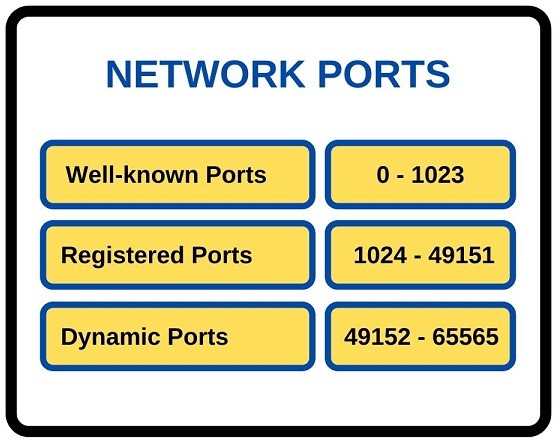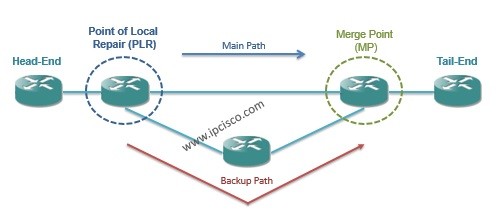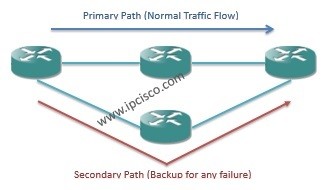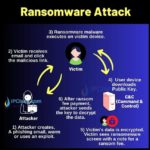What Happens After the Failure Recovered By Fast Reroute (FRR) ? After detecting the failure in an MPLS network, in Fast Reroute (FRR) mechanism, PLR switches the traffic to the protected tunnel. At the same time it sends a PATH ERR message to the Head-End. In this message, it is said that, the Primary LSP is active but the traffic is flowing through protection path. So in Head-End, the Primary LSP is up and active.
The certain guarantees of the traffic is also provided in backup link. This parameters send from the Head-End to the PLR by Fast Reroute Object.
After getting the PATH ERR message, Head-End starts the “Global Revertive” procedure. It starts a “retry-timer” and after this time expire, it searches a better Primary LSP and starts a CSPF calculation. This “retry-timer” is 30 seconds by default. If it achieve to find a better LSP, switches the traffic to that LSP. If it can not find a better LSP, then it searches after new retry-timer expires.
If a better LSP found and the traffic swicthes to it, a PATH TEAR Message is sent to the old Primary LSP by Head-End. And the old LSP, finishes the detour sessions. This is done for One-to-One Backup only, because at Facility Backup, the Bypass tunnel can protect another LSP too.
At the new LSP, the new detours are also built, because in the PATH Message that is sent on new LSP, still Fast Reroute (FRR) request exist.
For every LSP, there is “retry-timer” and “retry-limit”. The default “retry-timer” is 30 seconds. To configure it use the following command on Alcatel-Lucent 7750 Service Routers:
The default “retry-limit” is 0. This means that retry until a better path is found. To configure it use the following command on Alcatel-Lucent 7750 Service Routers:
By default the calculated LSP can be active forever. But this is configurable by “resignal-timer”. This is disabled by default. The minimum value for resignal-timer is 30 minutes. To configure “resignal-timer” use the below command:
After expire of this resignal-timer, Head-End make a new CSPF calculation. If it finds a better LSP, it switches the traffic to that LSP. If not, the the trafic remains in the same LSP.
If the first Primary LSP come online, then Head-End still needs to wait till resignal-timer expire. After that it make a new CSPF calculation and see the Primary again, and switches the traffic to the previous Primary LSP. Head-End does this optimization, whenever the resignal-timer expires.
If the alternate path can not found by HEad-End, LSP can be torn down or it let it stay on the Backup path. But to keep the traffic forever in the Backup path needs some RSVP messaging. Because without some periodic RSVP path and Resv messages, LSP will time-out. So these messages needs to be forwarded over the Backup link.
You can check the other parts of these MPLS Protection and Restoration Article series below.
MPLS Protection and Restoration – Part 1
MPLS Protection and Restoration – Part 2 (End-to-End Protection, Secondary Paths)
MPLS Protection and Restoration – Part 3 (Path Diversity in Secondary Paths)
MPLS Protection and Restoration – Part 4 (Local Protection, Fast Reroute)
MPLS Protection and Restoration – Part 5 (Fast Reroute Protection Types)
MPLS Protection and Restoration – Part 6 (RSVP Objects Used for MPLS Fast Reroute)
MPLS Protection and Restoration – Part 7 (Verification Commands on Alcatel-Lucent Routers)
MPLS Protection and Restoration – Part 8 (Actions After the Failure)
MPLS Protection and Restoration – Part 9 (Convergence Factors)
MPLS Protection and Restoration – Part 10 (Juniper Configuration Samples)
MPLS Protection and Restoration – Part 11 (Juniper Configuration Samples)
MPLS Protection and Restoration – Part 12 (Juniper Configuration Samples)
MPLS Protection and Restoration – Part 13 (Juniper Configuration Samples)
…YOU CAN REACH ALL THE “MPLS” ARTICLES AND CONFIGURATIONS BELOW…
MPLS Basics
What is MPLS?
Enabling MPLS on Cisco Router
MPLS Label Distribution Protocol, LDP
MPLS Label Distribution Protocol, LDP – Part 1
MPLS Label Distribution Protocol, LDP – Part 2
MPLS Label Distribution Protocol, LDP – Part 3 (Configuration on ALU)
MPLS Label Distribution Protocol, LDP – Part 4 (ECMP)
MPLS Label Distribution Protocol, LDP – Part 5 (Export and Import Policy, Prefix Aggregation)
MPLS Label Distribution Protocol, LDP – Part 6 (T-LDP)
MPLS Label Distribution Protocol, LDP – Part 7 (CR-LDP)
MPLS, RSVP-TE
MPLS, RSVP-TE – Part 1
MPLS, RSVP-TE – Part 2(Alcatel-Lucent Configuration)
MPLS Protection And Restoration
MPLS Protection and Restoration – Part 1
MPLS Protection and Restoration – Part 2 (End-to-End Protection, Secondary Paths)
MPLS Protection and Restoration – Part 3 (Path Diversity in Secondary Paths)
MPLS Protection and Restoration – Part 4 (Local Protection, Fast Reroute)
MPLS Protection and Restoration – Part 5 (Fast Reroute Protection Types)
MPLS Protection and Restoration – Part 6 (RSVP Objects Used for MPLS Fast Reroute)
MPLS Protection and Restoration – Part 7 (Verification Commands on Alcatel-Lucent Routers)
MPLS Protection and Restoration – Part 8 (Actions After the Failure)
MPLS Protection and Restoration – Part 9 (Convergence Factors)
MPLS Protection and Restoration – Part 10 (Juniper Configuration Samples)
MPLS Protection and Restoration – Part 11 (Juniper Configuration Samples)
MPLS Protection and Restoration – Part 12 (Juniper Configuration Samples)
MPLS Protection and Restoration – Part 13 (Juniper Configuration Samples)










Leave a Reply